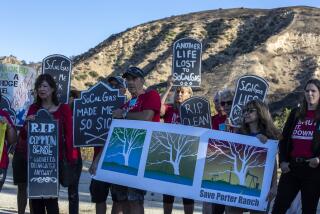Editorial: There’s no great answer for nuclear waste, but almost anything is better than perching it on the Pacific
One of the great failures in U.S. energy policy was that we’ve never figured out what to do with the lethally radioactive waste produced by nuclear power plants. That’s why the owners of the decommissioned San Onofre nuclear plant have had little choice but to keep their spent fuel rods on site, bundled up in concrete bunkers at the edge of the Pacific Ocean, dangerously close to an earthquake fault and millions of people — and hope for the best until the federal government finds a good place to put the deadly waste.
The feds don’t have one yet, but developments in court and in the marketplace could help move San Onofre’s waste somewhere considerably less risky. As part of a legal settlement earlier this month, Southern California Edison, which is the majority owner of the shuttered nuclear power plant, promised to make a good-faith effort to find a safer home for the 3.55 million pounds of nuclear waste at the plant. That’s a welcome shift for the company, which has been focused on moving its spent fuel rods into safer containers on-site.
And unlike in the past, it may have several choices for where to send the waste. Although there still are no federally licensed nuclear waste dumps, despite the billions of dollars ratepayers have paid to fund them, as of this year there are two proposals for temporary storage sites that could conceivably be ready for business by the early 2020s.
When it comes to waste that’s going to remain radioactive for tens of thousands of years, there are no great solutions.
The most promising is an underground facility in the southeast corner of New Mexico, 35 miles from any significant population center, operated by Holtec International, the nuclear storage company that makes the dry storage casks used currently by San Onofre. If there are no hitches in licensing, it could be ready to store spent nuclear fuel in about five years. That would incidentally be good timing for California’s last operating nuclear plant, Diablo Canyon, which is set to shut down its last reactor in 2025.
Another proposed short-term site is in Andrews, Texas, operated by Waste Control Specialists and currently storing low-level radioactive waste. But its prospects are less certain. Earlier this year the company put on hold its application to expand into high-level nuclear waste, citing financial reasons. Meanwhile, public opposition to the proposed expansion had been growing.
A third option is the Palo Verde Nuclear Generating Station in the Arizona desert about 50 miles from Phoenix. At the moment, Palo Verde holds a permit to store its own waste on site, but Edison is a part owner of the plant and presumably could have some sway in the decision to seek an expanded waste storage permit.
That there are real options at last for off-site storage is heartening. Although the nuclear waste at San Onofre is about as safe as it could be, the storage containers used aren’t designed for long-term storage. Yet any longer-term option will require tremendous political will to achieve. Having Edison contributing to that effort certainly can’t hurt.
As for truly permanent storage, the U.S. Department of Energy’s proposed Yucca Mountain site in Nevada still appears to be the safest place in the country for a permanent nuclear repository, though even if all the stars aligned it would take decades to open. The federal government needs to renew its efforts to bring the Yucca Mountain site into operation.
Doing so, however, will be a political challenge. After the federal government sunk $11 billion into the site’s development, President Obama halted work in 2010 as a favor to then-Senate Majority Leader Harry Reid (D-Nev.). And though the GOP generally seems more open to the project, Nevada Republican Sen. Dean Heller vociferously opposes it. Nevadans don’t generally like the idea of having nuclear waste in their state, but even they would have to concede that the remote and dry location built deep into a mountain is a better spot for radioactive material than in the middle of a seismically active population center.
Granted, when it comes to waste that’s going to remain radioactive for tens of thousands of years, there are no great solutions. But there are certainly better ones than continuing to hold more than 70,000 tons of nuclear fuel at about 120 operating and decommissioned nuclear plants across the country in facilities never intended for long-term storage, then hoping for the best.
Follow the Opinion section on Twitter @latimesopinion and Facebook
More to Read
A cure for the common opinion
Get thought-provoking perspectives with our weekly newsletter.
You may occasionally receive promotional content from the Los Angeles Times.










